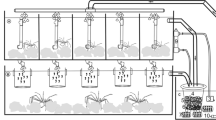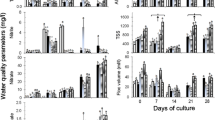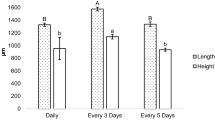Abstract
Larvae of Japanese smelt Hypomesus nipponensis have unique salinity adaptability and a small gape size; consequently, no system has been developed to feed them for stable high growth and survival. Therefore, suitable conditions for larval growth of Japanese smelt remain to be studied. In an earlier study, we developed a Japanese smelt rearing method using a closed recirculating system. Using that system for this study, we examined recirculation rate effects on Japanese smelt larval growth because the recirculation rate can affect larval feeding opportunities through regulation of the rotifer retention time in the rearing tanks. Using 0.2–0.3% salinity and water temperatures of less than 20 °C, we fed Japanese smelt larvae with SS-type rotifer and commercial feed. Results indicated that larval growth with a recirculation rate of less than 648% per day (LR) is superior to that achieved at a rate of over 2160% per day (HR). Moreover, rotifer density under the LR condition declines more slowly than under the HR condition. These results demonstrated that the recirculation rate affects their growth, perhaps by affecting the opportunities for larvae to ingest the rotifers. Furthermore, SS-type rotifers are available for feeding teleosts in a wide range of water temperatures and salinities.


Similar content being viewed by others
References
Alabaster JS, Shurben DG, Knowles G (1979) The effect of dissolved oxygen and salinity on the toxicity of ammonia to smolts of salmon, Salmo salar L. J Fish Biol 15:705–712
Asami H (2001) Gut contents of smelt larvae (Hypomesus nipponensis) in Lake Abashiri, a brackish lake, eastern Hokkaido. Sci Rep Hokkaido Fish Hatchery 55:19–25 (in Japanese)
Asami H (2004) Early life ecology of Japanese smelt (Hypomesus nipponensis) in Lake Abashiri, a brackish water, eastern Hokkaido, Japan. Sci Rep Hokkaido Fish Exp Stn 67:1–79 (in Japanese)
Chiba K (1988) The effect of dissolved oxygen on the growth of young ayu. Nippon Suisan Gakkaishi 54:175–181 (in Japanese with English abstract)
Eguchi H, Kurohagi T (1966) Recent observation on limnological condition of Lake Tōya, in Hokkaido. Sci Rep Hokkaido Fish Hatch 21:603–605 (in Japanese)
Fujikawa Y, Katayama S (2014) Spawning grounds and season of pond smelt Hypomesus nipponensis in Lake Shinji and Nakaumi, Japan. Aquacult Sci 62:375–384. https://doi.org/10.11233/aquaculturesci.62.375 (in Japanese)
Hamasaki K, Tsuruoka K, Teruya K, Hashimoto H, Hamada K, Hotta T, Mushiake K (2009) Feeding habits of hatchery–reared larvae of greater amberjack Seriola dumerili. Aquaculture 288:216–225. https://doi.org/10.1016/j.aquaculture.2008.11.032
Hirai N, Koiso M, Teruya K, Okuzawa K, Kobayashi M, Takebe T, Sato T, Nakamura K, Goto T, Hagiwara A (2012) Rearing conditions for humphead wrasse Cheilinus undulatus larvae, and introduction of the minute rotifer Proales similis as an initial live food. J Fish Tech 4:57–64 (in Japanese with English abstract)
Hirata Y, Hamasaki K, Imai A, Teruya K, Iwasaki T, Hamada K, Mushiake K (2009a) Effects of different photoperiods and water temperature on survival, growth, feeding and initial swim bladder inflation of greater amberjack Seriola dumerili larvae. Nippon Suisan Gakkaishi 75:995–1003. https://doi.org/10.2331/suisan.75.995 (in Japanese with English abstract)
Hirata Y, Hamasaki K, Teruya K, Mushiake K (2009b) Ontogenetic changes of body density of larvae and juveniles in seven–band grouper Epinephelus septemfasciatus and kelp grouper Epinephelus bruneus. Nippon Suisan Gakkaishi 75:652–660. https://doi.org/10.2331/suisan.75.652 (in Japanese with English abstract)
Iwai T, Tanaka H (1989) On the culture of pond smelt Hypomesus olidus (PALLAS) in larval stage. Suisanzoshoku 37:49–55. https://doi.org/10.11233/aquaculturesci1953.37.49 (in Japanese)
Kashiwagi M (1986) Effects of temperature and salinity on egg hatch of the ayu Plecoglossus altivelis. Bull Fac Fish Mie Univ 13:17–24
Kashiwagi M, Iwai T, Lopes ANG (1988) Effects of temperature and salinity on egg hatch of the pond smelt Hypomesus olidus. Bull Fac Bioresour Mie Univ 1:7–13
Kayano Y (2009) Changes of feeding behavior and growth in larval and juvenile stages of red spotted grouper Epinephelus akaara under rearing conditions. J Fish Tech 2:31–38 (in Japanese with English abstract)
Kido K, Watanabe Y, Nakamura Y, Okamura T (1991) Effect of ammonia on the survival of red sea bream. Suisanzoshoku 39:353–362 (in Japanese with English abstract)
Koiso M, Tezuka N, Sakae K (2013) Daily population growth rate of six Brachionus plicatilis sp. complex strains under different water temperatures and salinities. Aquacult Sci 61:1–7. https://doi.org/10.11233/aquaculturesci.61.001 (in Japanese)
Masuda Y, Miyamoto K (2020) Rearing Japanese smelt larvae and juvenile fed only with rotifer and formulated food. Aquacult Sci 68:327–335. https://doi.org/10.11233/aquaculturesci.68.327 (in Japanese with English abstract)
Masuda Y, Jinbo T, Imaizumi H, Hashimoto H, Oda K, Matsuda K, Teruya K, Usuki H (2013) Regulation of water temperature, feeding frequency and larval stocking density lead to shorter duration of larval stage of Japanese eel Anguilla japonica. Nippon Suisan Gakkaishi 79:198–205. https://doi.org/10.2331/suisan.79.198 (in Japanese with English abstract)
Matsunari H, Hashimoto H, Iwasaki T, Oda K, Masuda Y, Imaizumi H, Teruya K, Furuita H, Yamamoto T, Hamada K, Mushiake K (2013) Effect of feeding rotifers enriched with taurine on the growth and survival of larval amberjack Seriola dumerili. Fish Sci 79:815–821. https://doi.org/10.1007/s12562-013-0657-y
Nakamura T, Watanabe S (2001) Physical characteristics of the spawning ground of pond smelt, Hypomesus nipponensis in Kinu River, Tone River system, central Japan. Suisanzoshoku 49:507–508. https://doi.org/10.11233/aquaculturesci1953.49.507 (in Japanese with English abstract)
Okazaki T, Tanizawa K, Furuya K, Yoshida M (2017) Relationship between poor catch of Japanese smelt and zooplankton fauna in Lake Kawaguchi. Rep Yamanashi Pref Fish Tech Center 44:30–44 (in Japanese)
Randall DJ, Tsui TKN (2002) Ammonia toxicity in fish. Mar Pol Bul 45:17–23
Sato R (1952) Larval development of the pond smelt, Hypomesus olidus (PALLAS). Tohoku J Agr Res II 2:41–48
Senta T (1973) Spawning ground of the salmonoid fish Salangichthys microdon, in Takahashi River, Okayama prefecture. Jap J Ichthyol 20:25–28. https://doi.org/10.11369/jji1950.20.25 (in Japanese with English abstract)
Shiraishi Y (1961) The fisheries biology and population dynamics of pond–smelt, Hypomesus olidus (Pallas). Bull Fresh Fish Res Lab 10:1–263 (in Japanese)
Shiraishi Y, Tokunaga E (1958) Spawning and its physical environment of pond–smelt (Hypomesus olidus) in Lake Sagami. Bull Fresh Fish Res Lab 8:33–44 (in Japanese)
Shirota A (1970) Studies on the mouth size of fish larvae. Nippon Suisan Gakkaish 36:353–368. https://doi.org/10.2331/suisan.36.353 (in Japanese with English abstract)
Tabata K (1973) The evaluating methods for toxicity of industrial effluents to aquatic organisms (vol. 1) –the methods for evaluating TLm for some teleosts–. Ind Water 177:49–56 (in Japanese)
Takahashi Y (1990) Reduction of the amount of food organisms supplied and simplification of rearing operations in the seedling of the Japanese flounder. Suisanzoshoku 38:23–33. https://doi.org/10.11233/aquaculturesci1953.38.23 (in Japanese with English abstract)
Teruya K, Yoseda K (2006) Successful mass production of early stage larvae of kelp grouper Epinephelus bruneus in improved rearing conditions. Aquacult Sci 54:187–194. https://doi.org/10.11233/aquaculturesci1953.54.187 (in Japanese with English abstract)
Teruya K, Yoseda K, Oka M, Nishioka T, Nakano S, Mori K, Sugaya T, Hamasaki K (2008) Effects of photoperiod on survival, growth and feeding of seven band grouper Epinephelus septemfaciatus larvae. Nippon Suisan Gakkaishi 74:645–652. https://doi.org/10.2331/suisan.74.645 (in Japanese with English abstract)
Tominaga A, Yanai T (2006) Spawning grounds of pond smelt in the Koise River. Rep Fresh Fish Exp Stn Ibaraki Pref 40:23–27 (in Japanese)
Torao M (2012) Starvation limits of newly hatched larvae of wakasagi, Hypomesus nipponensis, and their downstream migration to Lake Abashiri. Sci Rep Hokkaido Fish Res Inst 82:33–40 (in Japanese)
Yamagishi H (1974) On the ecology of the youngs of the pond smelt, Hypomesus olidus (Pallas) in Lake Suwa: appendix. The relation of the progress of eutrophication in the lake to the annual catches of the pond smelt. Jap J Ecol 24:10–21. https://doi.org/10.18960/seitai.24.1_10 (in Japanese with English abstract)
Yamamoto Y, Kamoshida M, Takeuchi T (2013) Examination of suitable condition of recirculation rate in a closed recirculating system for larviculture of red sea bream, Pagrus major. Eco-Engineering 25:49–58. https://doi.org/10.11450/seitaikogaku.25.49 (in Japanese with English abstract)
Yoseda K, Dan S, Fujii A, Kurokawa Y, Kawai S (2003) Effects of different photoperiods on first–feeding success, early survival and digestive enzyme activities in coral trout Plectropomus leopardus larvae. Suisanzoshoku 51:179–188. https://doi.org/10.11233/aquaculturesci1953.51.179 (in Japanese with English abstract)
Acknowledgements
We would like to thank Mr. Hiroki Hoshikawa and the staff of the Nagano Prefectural Fisheries Experimental Station, and Mr. Jun Nagura and the staff of the Yamanashi Fisheries Technology Center for their helpful advice about rearing Japanese smelt larvae. We thank Dr. Kazuhisa Teruya, Dr. Hiroshi Kuwada, Dr. Masahiko Koiso, Mr. Shigenori Suzuki, Dr. Hiroshi Hashimoto, and Dr. Hiroyuki Matsunari for advice about teleost seed production using rotifers. Moreover, we thank Mr. Kouji Muto, Mr. Hidefumi Nakamura, Ms. Haruka Morino, Mr. Miyoshi Takayama, and the staff of Nikko Laboratory, FRA for experiment support. Rotifers were provided by the GeneBank of FRA.
Author information
Authors and Affiliations
Corresponding author
Additional information
Publisher’s Note
Springer Nature remains neutral with regard to jurisdictional claims in published maps and institutional affiliations.
The original online version of this article was revised to delete data availability statement.
Rights and permissions
Springer Nature or its licensor (e.g. a society or other partner) holds exclusive rights to this article under a publishing agreement with the author(s) or other rightsholder(s); author self-archiving of the accepted manuscript version of this article is solely governed by the terms of such publishing agreement and applicable law.
About this article
Cite this article
Masuda, Y., Miyamoto, K. & Sekine, S. Recirculation rate of rearing water affects growth of Japanese smelt Hypomesus nipponensis larvae. Fish Sci 89, 53–60 (2023). https://doi.org/10.1007/s12562-022-01650-w
Received:
Accepted:
Published:
Issue Date:
DOI: https://doi.org/10.1007/s12562-022-01650-w




